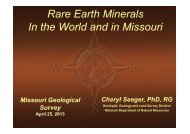You also want an ePaper? Increase the reach of your titles
YUMPU automatically turns print PDFs into web optimized ePapers that Google loves.
entirely on descriptions of field relations provided<br />
by Love (1964).<br />
I-80 On-ramp Area, Exit 91, East of Green<br />
River, NW¼SE¼ sec. 23, T. 18 N., R. 107 W.,<br />
Sweetwater County<br />
Mudstone and limestone of the Wilk<strong>in</strong>s Peak<br />
Member crops out at this location between the<br />
on-ramp and east-bound driv<strong>in</strong>g lane of I-80. The<br />
units exposed here match the descriptions of horizons<br />
6 through 10 on Lulu claim #2 (Love, 1964),<br />
which <strong>in</strong>clude UPZ 2 and UPZ 2a. UPZ 2 is<br />
hosted with<strong>in</strong> a green, blocky, calcareous mudstone<br />
(Sample 20120928JC-A) about 1 m (3 ft) below<br />
the base of the overly<strong>in</strong>g tan to gray, th<strong>in</strong>-bedded<br />
to lam<strong>in</strong>ated marlstone. UPZ 2a is hosted with<strong>in</strong> a<br />
green, blocky, calcareous siltstone and shale (Sample<br />
20120928JC-B), about 1 m (3 ft) below the<br />
overly<strong>in</strong>g tan, slabby, dolomitc marlstone. Neither<br />
of these samples is significantly enriched <strong>in</strong> REE or<br />
other <strong>elements</strong> of economic <strong>in</strong>terest.<br />
Lulu claims, NE¼SW¼ sec. 10, T. 17 N., R.<br />
106 W., Southern Sweetwater County<br />
In this area, the uppermost Tipton Shale Member<br />
and lower Wilk<strong>in</strong>s Peak Member of the Green<br />
River Formation are exposed. The Tipton Shale is<br />
composed of a brown to gray, well-<strong>in</strong>durated oil<br />
shale. The lower 3 m (10 ft) of the Wilk<strong>in</strong>s Peak<br />
Member consists of marly, sandy siltstone, and<br />
marly shale (horizons 2 and 3 of Love, 1964). UPZ<br />
1 is hosted <strong>in</strong> the upper 2 m (6 ft) of horizon 4,<br />
which <strong>in</strong>cludes a lower gray to red, irregularly bedded,<br />
blocky, slope form<strong>in</strong>g, dolomitic marlstone<br />
with a white powdery fracture coat<strong>in</strong>g m<strong>in</strong>eral<br />
(Sample 20120928JC-E). Horizon 4 also <strong>in</strong>cludes<br />
an upper gray to brown, <strong>in</strong>terlayered sandy siltstone<br />
and marlstone (Sample 20120928JC-C).<br />
A blocky, green mudstone to siltstone (Sample<br />
20120928JC-D) that may conta<strong>in</strong> UPZ 2 or 2a<br />
crops out about 15 m (50 ft) above horizon 4; this<br />
layer is similar to the two rock units of samples<br />
20120928JC-A and 20120928JC-B. REE enrichment<br />
is not present <strong>in</strong> any of these samples, but<br />
all three are enriched <strong>in</strong> lithium, five to 6.5 times<br />
crustal abundance.<br />
South Firehole Canyon, NW¼SE¼, sec. 20, T.<br />
16 N., R. 106 W., Southern Sweetwater County<br />
At South Firehole Canyon (fig. 22), Love (1964)<br />
reported the presence of UPZs 1, 2, 2a, 3, 3a, and<br />
possibly 4, with up to 0.016 percent eU, 0.009<br />
percent uranium and 10.56 percent P 2 O 5 <strong>in</strong> UPZ<br />
2a. The Wilk<strong>in</strong>s Peak Member here is similar to<br />
the section described by Love (1964) at Lulu claim<br />
#2, except that beds 2 through 6 (Love, 1964) are<br />
replaced by about 12 m (39 ft) of resistant ridgeform<strong>in</strong>g,<br />
gray to tan, platy to fissile, dolomitic<br />
siltstone, with th<strong>in</strong> <strong>in</strong>terbeds of non-resistant<br />
mudstone and shale. This unit exhibits lateral variations<br />
<strong>in</strong> color, <strong>in</strong>clud<strong>in</strong>g bright red and rusty areas.<br />
Background radioactivity at the site was 56 cpm.<br />
About 3 m (10 ft) above the base of the Wilk<strong>in</strong>s<br />
Peak Member is a radioactivity anomaly up to 2.5<br />
times the background (140 cpm). The anomaly<br />
is with<strong>in</strong> gray to tan (weathered), th<strong>in</strong>-bedded<br />
(about 1 cm or 0.4 <strong>in</strong>) to fissile, limonite-bear<strong>in</strong>g<br />
dolomitic siltstone (Sample 20121129JC-A); the<br />
stratigraphic position of the anomaly is equivalent<br />
to bed 4 (table 19, Love, 1964, Measured Section),<br />
which conta<strong>in</strong>s UPZ 1. Bedd<strong>in</strong>g at the sample site<br />
strikes 295˚ and dips 4˚ SW.<br />
A radioactivity anomaly up to 2.3 times background<br />
(130 cpm) occurs with<strong>in</strong> bed 7 (table 19),<br />
about 15 m (50 ft) above the base of the Wilk<strong>in</strong>s<br />
Peak Member. Bed 7 consists of green, slope form<strong>in</strong>g<br />
<strong>in</strong>terbedded mudstone and shale. The radioactivity<br />
anomaly is associated with UPZ 2, which is<br />
hosted <strong>in</strong> a layer of green, weakly calcareous shale<br />
(Sample 20121129JC-B), about 0.5 m (20 <strong>in</strong>)<br />
below the base of bed 8, which is composed of gray<br />
to tan, fissile, dolomitic siltstone.<br />
Uraniferous phosphatic zone 2a, hosted <strong>in</strong> bed 9<br />
(table 19), is associated with a radioactivity anomaly<br />
up to 10.6 times background (590 cpm) about<br />
19 m (62 ft) above the base of the Wilk<strong>in</strong>s Peak<br />
Member. Bed 9 consists of green, slope form<strong>in</strong>g,<br />
<strong>in</strong>terbedded mudstone and shale; UPZ 2a occurs<br />
with<strong>in</strong> green, blocky, noncalcareous mudstone<br />
(Sample 20121129JC-C), about 0.5 m (20 <strong>in</strong>)<br />
below the base of the gray to tan fissile calcareous<br />
siltstone of bed 10 (fig. 23).<br />
58



